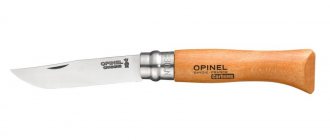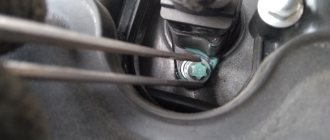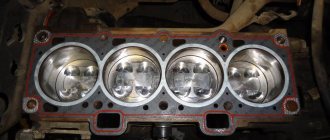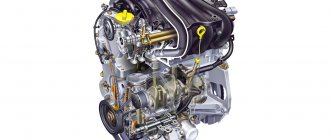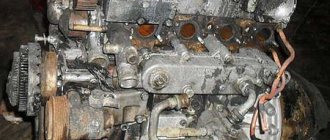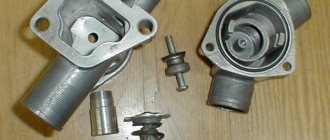February 17, 2015 Lada.Online 423 850 31
Depending on the year of manufacture, the Largus may be equipped with a Renault or VAZ engine. Currently, only domestic engines are installed on this car. Let's take a closer look at the technical characteristics of Lada Largus engines, as well as the features of their assembly.
- Renault-Nissan K7M
(8 valves) with a volume of 1.6 liters is capable of developing a power of 84 hp. This motor is installed on the “standard” and “norm” configurations. - Renault-Nissan K4M
(16 valves) is slightly more powerful, also 1.6 liters, but has a power of 105 hp. or 77 kW. The motor is provided for the “luxury” configuration. - VAZ 11189
(1.6 liter, 87 hp, 8 valves) began to be installed instead of K7M in 2015. - VAZ 21129
(1.6 liter, 106 hp, 16 valves) began to be installed instead of Renault K4M in October 2021. - VAZ 11182
(1.6l., 90hp, 8kl) began to be installed on Largus FL from March 2021
Both are Renault Alliance engines. Since December 2015, AVTOVAZ began installing its 8-valve VAZ-11189 engine. You can get acquainted with its pros and cons from this review.
Both engines from Renault-Nissan are paired with a 5-speed manual transmission. At the moment, AVTOVAZ does not plan to equip the Lada Largus with an automatic transmission.
Lada Largus engines are distinguished by high elasticity, and the manual gearbox is distinguished by precise gear shifting. For dynamic acceleration and confident overtaking, the engine power is quite enough. Both Lada Largus engines comply with Euro 4 environmental requirements.
Depending on the vehicle configuration, there are several options for installing auxiliary equipment on the engine:
- car with non-power steering;
- car without power steering with air conditioning;
- vehicle with hydraulic power steering;
- car with hydraulic power steering and air conditioning.
Content
- Who is the seven-seater cabin suitable for?
- Are there any differences in the configurations?
- What engines are on the Lada Largus?
- How does the Cross version differ from the regular one?
- What problems might you encounter?
- What to look for when choosing a Lada Largus
- Which Largus to choose
LADA Largus is one of the most affordable station wagons on the Russian market. On the secondary market it is sold on average for 461 thousand rubles.
The model went on sale in 2012 and has never been updated since then. You can choose from 5- or 7-seater body styles, a van or a Largus Cross raised by 25 mm.
Until 2021, Largus was sold with French engines, and after they were replaced by Russian engines of the same displacement. We'll look into this article about which Largus is better and which modification to choose on the used market.
What engines are installed on Largus: types and characteristics of internal combustion engines
The Russian budget car Lada Largus is built on the VO platform and is the first joint project of the Renault-Nissan alliance and AvtoVAZ. In fact, the car is a copy of the first generation Renault/Dacia Logan MCV station wagon.
A car with a five-speed manual transmission began to be produced in 2012 in Togliatti. The model is available in three versions: a Largus F90 cargo van with solid rear and side panels, a 5- and 7-seater Largus R90 station wagon, and a Largus Cross.
Over the years, the car received various internal combustion engines, which have a number of design differences and unique characteristics. Next, we will look at which Largus engine was installed on this model in a given year, as well as what features, advantages and disadvantages different versions of power units have.
Model Lada Largus: engine
So, it is important to know what engines are installed on Largus, the technical differences and features of the power plant. Let's start with the fact that the first cars were equipped with engines: 8-valve Renault-Nissan K7M and 16-valve Renault-Nissan K4M.
Today, cars are equipped only with domestic engines: 8-valve VAZ 11189 and 16-valve VAZ 21129. Let us examine in more detail all Lada Largus engines, their technical characteristics and assembly features.
On the Lada Largus, the Renault-Nissan K7M engine (8 valves) with a volume of 1.6 liters and a power of 82 horsepower (60 kW) is a gasoline engine on versions of cars in the “norm” and “standard” configurations. Cars with the luxury package are equipped with Lada Largus 16-valve Renault-Nissan K4M gasoline engines with a displacement of 1.6 liters and a power of 102 horsepower (75 kW).
Since December 2015, instead of the Renault-Nissan K7M gasoline engine, cars began to be equipped with an 8-valve Lada Largus VAZ 11189 engine with a volume of 1.6 liters and a power of 87 horsepower (64 kW).
Since October 2021, the Largus Renault K4M gasoline engine has replaced the Largus 16 valve VAZ 21129 with a volume of 1.6 liters and a power of 106 horsepower (78 kW). Please note that engines produced by Renault-Nissan comply with Euro 4 environmental standards, and engines from the VAZ manufacturer comply with Euro 5 environmental standards.
Options for installing additional equipment on the internal combustion engine of a Lada Largus car:
Pros and cons of Lada Largus engines
Let's start with the fact that previously the engine assembly for the Lada Largus was produced by the Renault plant in Spain. Later, K4M engines began to be assembled at AvtoVAZ. This did not affect the build quality; the motors meet all international standards.
The main technical characteristics of engines produced by Renault-Nissan are as follows: Renault-Nissan engines are 4-cylinder, have an in-line arrangement of cylinders. The injection type of the K4M and K7M engines is distributed, electronically controlled. Recommended fuel: Premium-95 gasoline GOST 51105-97. The toxicity standard corresponds to Euro 4.
Among the differences between the Largus engine Renault K4M and the Largus engine Renault K7M:
In turn, the main disadvantages of the Renault-Nissan K7M internal combustion engine:
- fuel consumption is quite high;
- sometimes the speed fluctuates at idle;
- valve adjustment should be carried out every 20-30 thousand kilometers;
- lack of hydraulic compensators;
- a broken belt bends the valve; the belt must be replaced every 60 thousand kilometers;
- the likelihood of crankshaft oil seals leaking;
- vibration and noise during operation.
Who is the seven-seater cabin suitable for?
The third row of seats is useful not only for large families. The seven-seater modification is suitable for both travel enthusiasts and taxi companies. The third row of the Largus is spacious. Not only children, but also short adult passengers will fit there. Rear passengers will have not only seats and seat belts, but also windows and even cup holders.
The trunk of the Largus in a five-seater version holds 560 liters, and if you use all seven seats, then there will be another 135 liters left in the trunk to accommodate a couple of backpacks. But if you fold all the seats, the space increases to 2,350 liters!
Cars with the capacity of a minivan are a rarity on the Russian market, and in the segment up to 400 thousand rubles, only one option is available - the Lada Largus.
Also read: Not everything is so bad: pros and cons of LADA Largus
Are there any differences in the configurations?
The basic Largus package includes central locking with an immobilizer, one airbag for the driver, manual windows, ISOFIX mounts, mud flaps on the front wheels and “stamping”. Standard equipment adds foglights, heated front seats and another airbag for the passenger.
Largus has many configurations, but they differ only slightly. For example, the only difference between the luxury version and the standard version is the air conditioning. The difference between luxury and standard in the cross version is only in the wheels - casting instead of stamping.
Also read: Berry again? Review of Lada Kalina II
What engines are on the Lada Largus?
The Largus is equipped with a 1.6-liter engine, which, on the one hand, has established itself as a relatively reliable unit. On the other hand, due to the maximum economy with which it was created, it requires a lot of attention and maintenance. The motors are not quiet and smooth and, despite the same volume, operate differently. We'll tell you which Largus engine is better.
Until 2012, Largus were equipped with engines from Logan: 1.6 liters with a power of 84 or 102 hp. With. With timely replacement of spark plugs, oil with filters and timing belt, French engines run up to 150 thousand km. The belt lasts up to 120 thousand km, and replacing it costs about 4 thousand rubles.
Modern Largus are equipped with Russian 8- or 16-valve engines with a volume of 1.6 liters and a power of 87 or 106 horses. In these engines, special attention should be paid to the condition of the timing belt, which lasts up to 60 thousand km. If it breaks, the valve will bend. In addition, the hydraulic compensators that regulate the valves are not provided in the engine, so this will have to be done at a service center at least every 30 thousand km.
Also, Russian engines have problems with throttle valve failure and frequent failure of certain sensors. In terms of noise and vibration levels, domestic engines are also inferior to French ones.
With foreign engines, French gearboxes were installed in Largus. A five-speed manual transmission lasts up to 200 thousand km, and the clutch lasts about as long as the gearbox itself. A new one will cost 4.5 thousand rubles, and the cost of the box itself starts from 70 thousand rubles. Automatic transmission has never been installed on Largus.
Also read: Review of used Lada Priora: is it worth buying
Engine design 8 valves Lada Lagrus
If you have ever owned a VAZ car, then you can already imagine how the 8-valve VAZ Lada Largus engine works.
This is a cast iron block that resists wear well. Aluminum cylinder head and valve cover, as well as a pan made of steel.
Number of cylinders - 4, number of valves - 8.
The timing drive, traditionally for Russian front-wheel drive cars, is belt driven. This made it possible to reduce the noise of the engine, but at the same time reduced the life of the belt. Although replacing the Lada Largus timing belt and rollers is a simple procedure that can be performed even in any garage.
There are no hydraulic compensators in this engine. Their installation would have increased the cost of the design, so the factory abandoned them. Valve clearances are adjusted using special shims. This procedure should be carried out at least once every 30 thousand kilometers. In general, such work will not hit your pocket hard, since there are plenty of specialists, and adjusting washers are available in different sizes for quite reasonable money.
The intake manifold is plastic, the exhaust has a cat manifold. The throttle is electronic.
Injection - distributed through injectors in the fuel rail.
How does the Cross version differ from the regular one?
The prefix “cross” to a model name almost always means an artificially created illusion of a crossover. In the case of the Largus, these are unpainted bumpers and plastic linings on the arches and sills, so as not to scratch the most vulnerable parts of the body on dirt roads. The regular Largus is equipped with 15-inch wheels, while the Largus Cross is equipped with 16-inch wheels. The ground clearance of the cross version is 210 mm, while on the regular Largus it is 185 mm.
Car interiors are almost no different from each other. In the cross version, the seats are decorated with oblique stitching, and the dashboard is made of two colors.
For the cross version, the engineers even changed the suspension slightly: the shock absorber body and rear springs are longer. This allows you to feel more comfortable when driving on bad roads than on a regular Largus.
At the same time, Largus Cross spends 1.5 liters of gasoline more than a regular station wagon: 11.5 liters versus 10 liters per 100 km!
Also read: Rare Ladas on the secondary market
What is the reason for its popularity: the advantages of Lada Largus
There is no need to judge the appearance of the Largus: the current station wagon is a copy of the Dacia Duster MCV, originally from the early 2000s. AvtoVAZ designers did not bother to change the appearance of the model, but this did not scare off the target audience: practical drivers do not put design at the forefront.
The main trump cards of the domestic “heel” are capacity and price. From a car with a spacious trunk of more than 600 liters, the interior is transformed into a seven-seater car. And with two rows of seats folded, a fifth dimension opens up, containing almost 2.5 thousand liters of cargo! At the same time, the third row of seats is by no means just for show, like many crossovers.
Not only legless dwarfs, tiny animals or children will be able to sit comfortably in the last row. Even two adults of standard build and height can survive a long trip there, because a seven-seater cabin is needed not only by large families, but also by those who have many friends. And thanks to the rectangular shape of the body and interior trim without bevels, it is easy to carry long items in the trunk: boards, building materials, oversized cargo, etc. Practicality is the Largus’s ace in the hole.
Low cost is the second plus of the model. Maintenance costs are also low and spare parts are easy to find. Simple optics and a primitive design in this case play into the hands of the model. No matter how much journalists talk about how “Lada rises from its knees,” Togliatti has not yet learned how to assemble reliable automatic transmissions, let alone more complex and smart designs. Therefore, the simpler, the more reliable and cheaper.
Read also: Who invented the thorn sign
Another advantage of the model is its ground clearance. For the regular version of LADA Largus it reaches 170 mm, for the cross version - 200 mm.
What problems might you encounter?
The Largus suspension can hardly be called comfortable, but it is reliable. In seven-seater versions and vans, ball joints quickly fail due to the high load on the rear axle. The cost of a new spare part is from 1,000 rubles. Shock absorbers last up to 100 thousand km, but wheel bearings and CV joint boots last no more than 30 thousand km. Original brake pads last up to 40 thousand km, brake discs - up to 50 thousand km, so we recommend changing them at the same time.
Electronics are another weak point of the Lada Largus. When the contacts oxidize, the instrument panel malfunctions and displays unreliable information. And when several diodes in the generator bridge burn out, the battery stops charging altogether.
Rust is a friend of the LADA Largus, which goes hand in hand with it almost from the factory. First of all, doorways and sills are affected, then the engine compartment, hood and bumper. The reason for rapid corrosion is the poor quality of the paintwork.
Also read: How to sell Lada profitably
What to look for when choosing a Lada Largus
The model appeared on the market seven years ago, so finding a copy with one or two owners is quite possible (every second Largus, according to statistics from avtocod.ru). If there were more owners, it is unlikely that the car was looked after carefully.
Every third station wagon is sold broken or with unpaid fines, every sixth is on lease or has traffic police restrictions. “Largus” are also seen in passenger transportation; in the secondary market this is a third of all cars sold. The same amount is sold in the pledge. We were “lucky” to run into just such specimens.
The first is the “regular” Largus 2015. with mileage 125 thousand km:
The car was issued a duplicate title, and most likely it is a credit car.
The report showed one accident that occurred in 2015, and calculations were made in 2021. The repairs were carried out based on one problem, and their total amount exceeded 744 thousand rubles. Many parts were replaced. Apparently the car was in a serious accident.
The second lien Largus was given in the Cross version. 2021, 14 thousand km, 1 owner, 6 months of operation:
The check did not reveal any other problems other than the deposit:
But even with this problem, it is risky to rent a car. All encumbrances after the purchase will fall on the new owner.
Also read: All Russian cars are bad: truth or stereotype
Lada Largus
Largus with a 16-valve K4M engine producing 105 hp. was more popular than the version with the 84-horsepower eight-valve K7M engine of Romanian production, which was frankly rather weak. Why "was"? But because the transition to Euro 5 was a death sentence: driving this engine into new standards means coming to terms with the inevitable loss of power and torque, and it’s not a hero anyway. In addition, it is not produced at AVTOVAZ - therefore, it falls into the category of foreign currency components.
An elegant move was found, and for rubles: under the hood, VAZ’s original VAZ-1118 eight-valve engine was registered. A Largus with such an engine costs from 497,500 rubles for a van and from 524,500 rubles for a station wagon.
Read also: Mercedes s500 w220 photo
The engine was given its own index, VAZ‑11189, since the supports and the entire set of attachments (power steering pump, generator, air conditioning compressor) were changed. But the essence is still the same: this engine with a lightweight connecting rod and piston group is well known to owners of front-wheel drive Ladas and Datsuns as a reliable and easy-to-maintain unit.
What did you get regarding the foreign K7M engine? Power 87 “horses” (+3 hp), maximum torque 140 Nm (+17 Nm). The maximum speed of the five-seater station wagon increased by 2 km/h, the van and seven-seater station wagon by 3 km/h. The five-seater Largus accelerates to hundreds by three tenths of a second, the seven-seater by a second.
Another advantage: the French engine requires AI-95 gasoline, while ours is officially allowed 92. Fuel consumption in the service documents is indicated as before, but I dare to assume that in real life the VAZ engine will be less voracious.
To install the VAZ-11189 engine on the Largus, a rearrangement was required: the battery was moved, the fuse box was changed, and the coolant expansion tank was moved to the right wing. In its place is now an air filter housing from Vesta. The air intake resonator is, of course, also a new model. Hoses, lines, and electrical wiring harnesses are laid differently.
Paired with the new engine is a 5-speed JR5 gearbox, designed for torque up to 200 Nm. It is familiar from the cars of the Renault-Nissan alliance - it is installed, for example, on the Sandero Stepway. The gearbox is adapted for the Russian engine: gear pairs with different gear ratios are selected. The drive of the switching mechanism is cable. But the clutch is controlled by hydraulics.
In addition, the car received a new clutch housing, common with the XRAY model, as well as a driven disc and LuK basket.


